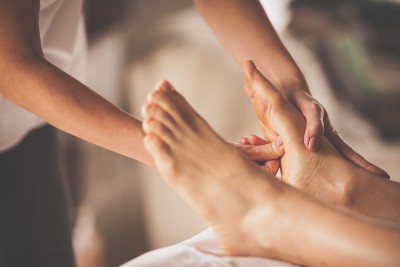Could Your Foot Pain Be from High Arches?
If you often struggle with foot discomfort, instability or trouble finding shoes that fit properly, you might have pes cavus, also known as high arches. One quick way to check: Dip your foot in shallow water and step on a piece of cardboard. If only the outer edge of your footprint shows, you likely have a cavus foot—a structural issue where the arch is significantly higher than normal.
High arches aren’t just a cosmetic difference—they can lead to serious foot pain, gait problems and increased risk of injury. Thankfully, solutions exist, ranging from conservative care to advanced cavus foot surgery.
Common Symptoms of High Arch Foot Pain
High arches cause an uneven distribution of weight across your foot. Instead of the arch absorbing shock, the stress shifts to the heel and forefoot.
“Your arch runs under the foot—from the toes to the heel. And when you stand or walk on high arches, you put an excessive amount of weight on the ball and heel of the foot,” explains Jeffrey Levy, D.O., a fellowship-trained orthopedic foot and ankle surgeon with Riverside Orthopedic & Sports Medicine Specialists.
You may experience:
- Pain or fatigue in the foot or ankle
- Frequent ankle sprains due to instability
- Calluses on the ball, heel or edge of the foot
- Hammer toes or claw toes (deformities caused by muscle imbalance)
- Foot drop (difficulty lifting the front of the foot)
- Stress fractures or frequent injuries
What Causes Pes Cavus?
Cavus foot may appear in one or both feet and can develop at any age. While some people are born with it, others acquire it due to medical conditions. Contributing causes include:
- Hereditary structural foot anomalies
- Traumatic injury
- Charcot-Marie-Tooth disease
- Cerebral palsy
- Muscular dystrophy
- Spina bifida
- Stroke
- Clubfoot
“High arches are often linked to underlying neurologic disorders or muscular conditions. That’s why a thorough diagnosis is essential,” says Dr. Levy.
How Cavus Feet Are Diagnosed
Diagnosing high arch foot conditions involves a comprehensive physical examination and imaging studies. Your orthopedic foot and ankle specialist will evaluate arch flexibility, foot shape and walking pattern. If neurological involvement is suspected, further testing may be necessary.
Common tests include:
- X-rays of the foot and spine
- MRI (especially if a spinal or nerve condition is suspected)
- Electromyography (EMG)
- Nerve conduction studies
- Genetic testing
A referral to a neurologist may be necessary to further explore any nerve issues that may be present.
Non-Surgical Cavus Foot Treatment Options
Not all cavus feet require surgery. Conservative care is often the first step.
“We typically start with bracing, custom orthotics and physical therapy to relieve pain and stabilize the foot,” says Dr. Levy.
Your personalized care plan may include:
- Activity modification (avoid high-impact activities)
- Custom orthotics (to support the arch and improve weight distribution)
- Ankle-foot orthosis (AFO) braces for added stability
- Stretching and strengthening through physical therapy
These methods often provide relief for mild to moderate cases of high arch foot pain.
Cavus Foot Surgery: When Is It Needed?
If pain persists or deformity worsens, cavus foot correction surgery may be necessary. The purpose of surgery is to correct foot alignment, relieve areas of excess pressure and minimize the risk that future issues will develop.
“Our treatment recommendation will depend on your specific diagnosis, the cause of your high arches, and the type of damage and deformity in your foot,” explains Dr. Levy. “Typically, during surgery, we realign the foot or lower the arch by cutting and repositioning the bones.”
Surgical options may include:
- Repositioning bones to lower the arch
- Repairing or transferring tendons
- Lengthening tight muscles (like the calf muscle)
- Ligament repair for joint stabilization
- Joint fusion to eliminate painful motion
- Fracture repair, if present
“Our goal is to give your body the ability to distribute weight evenly along the inside and outside edges of the foot,” adds Dr. Levy. “We may perform several procedures to correct the cavus foot and help you feel better.”
When to See a Specialist
If you’re dealing with recurring arch pain, frequent sprains or notice changes in your foot structure, don’t delay. Early intervention can prevent long-term issues and help you stay active.
To get expert care for pes cavus, foot drop or high arch deformities, schedule an appointment with Dr. Jeffrey Levy at Riverside Orthopedic & Sports Medicine Specialists by calling 757-534-9988.



